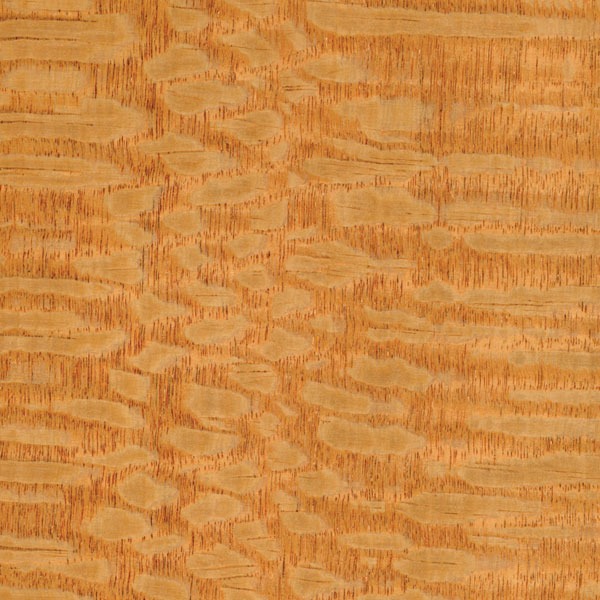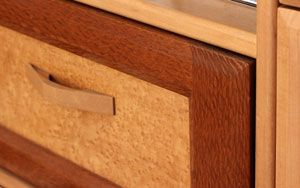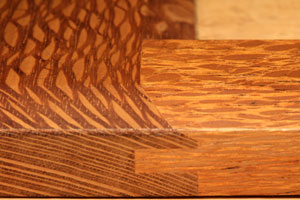 Sponsored by: Pollmeier Inc. European Beech: Durable, Sustainable and Versatile.
Sponsored by: Pollmeier Inc. European Beech: Durable, Sustainable and Versatile.
 Lacewood is a term that has been adopted by many wood species from around the world. The term most likely is derived from the wood’s distinctive lacey appearance, which has also been described as speckled, flecked and flakey.
Lacewood is a term that has been adopted by many wood species from around the world. The term most likely is derived from the wood’s distinctive lacey appearance, which has also been described as speckled, flecked and flakey.
There are two main species of wood termed “lacewood,” notes Rick Banas, vice president, Interwood Forest Products. “The smaller (diameter) of the two species, South American lacewood (Louro Faia), has a color ranging from cream to salmon and sometimes towards a greyish red,” he said. “The lace figure starts out as a small pebble and develops into large flakes as one cuts perpendicular to the growth rings. Due to the size of the log and the color ranges it is difficult to get large sequences of similar lace character.”
The larger of the species, Australian lacewood, also known as silky oak, has a consistent creamy color and a more consistent lace character. “The wood has an oily ‘teak like’ feel. Only logs which follow strict Australian government regulations can be harvested,” Banas added.
Ang Schramm, director of technical services at Columbia Forest Products also weighed in on the topic. “Australian silky oak (Cardwellia sublimis) from the family Proteaceae, or, as it is frequently called, lacewood, is characterized by its lustrous ruddy heartwood coloration and its enlarged rays that give it a lacy look that appears to glisten on the radial (quarter sliced or sawn) surface of the wood. It is not as permeable as many decorative species, but it does take a finish nicely. It has long been used in veneer form for architectural millwork, moldings, wall paneling, cabinetry, flooring, and fine furniture, often as an accent species,” said Schramm.
 Schramm also identified a third species in the “lacewood” group. “The term lacewood is sometimes also ascribed to European plane (Platanus hybrida) from the family Platanaceae. Also known as London plane, it is a relative of American sycamore (P. occidentalis), sometimes called American plane. The light reddish brown heartwood takes finishing material well, and like the Australian species, it is highly prized for use in high-end furniture, cabinetry, and millwork,” said Schramm.
Schramm also identified a third species in the “lacewood” group. “The term lacewood is sometimes also ascribed to European plane (Platanus hybrida) from the family Platanaceae. Also known as London plane, it is a relative of American sycamore (P. occidentalis), sometimes called American plane. The light reddish brown heartwood takes finishing material well, and like the Australian species, it is highly prized for use in high-end furniture, cabinetry, and millwork,” said Schramm.
But although the woods can share the same name, there are discernible differences, said Jim Dumas, owner of Certainly Wood. “Modern ‘Brazilian lacewood’ is quite different from the true Australian Lacewood that the reputation was built on. Brazilian lacewood, (Louro Faia), is coarse by comparison and far less uniform in color.
 “When we buy ‘Brazilian Lacewood’ we buy a grade that most closely matches the old Australian lacewood. Along with the criteria for close to uniform button size, it means that we purchase about 10 percent of the veneer that we’re shown,” Dumas said.
“When we buy ‘Brazilian Lacewood’ we buy a grade that most closely matches the old Australian lacewood. Along with the criteria for close to uniform button size, it means that we purchase about 10 percent of the veneer that we’re shown,” Dumas said.
Vladimir Grischenko of Custom Cabinetry Design, works with lacewood, sometimes teaming it with woods like plain maple or bird’s-eye maple veneer. “Lacewood is a beautiful, very stable wood, with minimum to almost to no-shrinkage after proper kiln drying. Lacewood edges from a burgundy-red color to goldish red with nice reaction to the light changes.”
Although easy to work, Grischenko recommends increasing clamping time for the gluing process about 50 percent compared to other non-flakey species.
 In addition to furniture and cabinetry, Cardwellia sublimis and related lacewood species have a wide range of uses, including architectural millwork and paneling, musical instruments, flooring and specialty items. As well as its distinctive figure, lacewood is prized for its silvery sheen and silky gloss finish, sometimes called florescence.
In addition to furniture and cabinetry, Cardwellia sublimis and related lacewood species have a wide range of uses, including architectural millwork and paneling, musical instruments, flooring and specialty items. As well as its distinctive figure, lacewood is prized for its silvery sheen and silky gloss finish, sometimes called florescence.






Have something to say? Share your thoughts with us in the comments below.